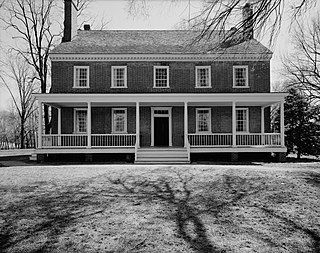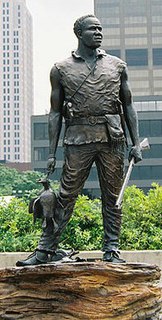
Meriwether Lewis was an American explorer, soldier, politician, and public administrator, best known for his role as the leader of the Lewis and Clark Expedition, also known as the Corps of Discovery, with William Clark.

William Clark was an American explorer, soldier, Indian agent, and territorial governor. A native of Virginia, he grew up in prestatehood Kentucky before later settling in what became the state of Missouri. Clark was a planter and slaveholder.

Sir John Ross was a British Royal Navy officer and Polar explorer. He was the uncle of Sir James Clark Ross, who explored the Arctic with him, and later led expeditions to Antarctica.

Toussaint Charbonneau was a French Canadian explorer and trader, and a member of the Lewis and Clark Expedition. He is also known as the captor-husband of Sacagawea.

The Corps of Discovery was a specially-established unit of the United States Army which formed the nucleus of the Lewis and Clark Expedition that took place between May 1804 and September 1806. The Corps, which was a select group of volunteers, were led jointly by Captain Meriwether Lewis and Second Lieutenant William Clark. Commissioned by President Thomas Jefferson, the Corps' objectives were scientific and commercial even – to study the area's plants, animal life, and geography, and to learn how the Louisiana Purchase could be exploited economically.
Jean Baptiste Charbonneau was a Native American-French Canadian explorer, guide, fur trapper trader, military scout during the Mexican–American War, alcalde (mayor) of Mission San Luis Rey de Francia and a gold prospector and hotel operator in Northern California. His mother was a Shoshone Indian known as Sacagawea. He spoke French and English and learned German and Spanish during his six years in Europe from 1823 to 1829. He spoke Shoshone, his mother tongue, and other western American Indian languages, which he picked up during his years of trapping and guiding.
John Newman may refer to:
This is the timeline of the Lewis and Clark Expedition through the American West (1803–1806).

John Colter was a member of the Lewis and Clark Expedition (1804–1806). Though party to one of the more famous expeditions in history, Colter is best remembered for explorations he made during the winter of 1807–1808, when he became the first known person of European descent to enter the region which later became Yellowstone National Park and to see the Teton Mountain Range. Colter spent months alone in the wilderness and is widely considered to be the first known mountain man.

Private John Shields (c1769–1809) was, at about 35 years old, the second oldest member of the Lewis and Clark Expedition and its oldest enlisted member. Shields, born in Virginia's Shenandoah Valley, moved at about 14 years old to the wilderness of Tennessee, helped build and lived in a family fort that provided protection from Native Americans, traveled with Captain Meriwether Lewis, Second Lieutenant William Clark, and Native American Sacagawea to the Oregon Coast where he helped build Fort Clatsop, and then returned to St. Louis, Missouri. At the completion of this great adventure Shields hunted and trapped with the famous American pioneer Daniel Boone.

Historic Locust Grove is a 55-acre 18th-century farm site and National Historic Landmark situated in eastern Jefferson County, Kentucky. The site is owned by the Louisville Metro government, and operated as a historic interpretive site by Historic Locust Grove, Inc.

York was an African-American explorer best known for his participation with the Lewis and Clark Expedition. Enslaved by William Clark's father and passed down through a will to William Clark, he performed hard manual labor without pay, but participated as a full member of the expedition. Like many other expedition members, his ultimate fate is unclear. There is evidence that after the expedition's return, Clark had difficulty compelling York to resume his former status, and York may have later escaped or been freed, but nothing is entirely clear on this.

Nathaniel Hale Pryor (1772–1831) served as Sergeant in the Lewis and Clark Expedition.

Seaman, a Newfoundland dog, became famous for being a member of the first American overland expedition from the Mississippi River to the Pacific coast and back. He was the only animal to complete the entire trip. He was purchased for $20 in Pittsburgh, Pennsylvania by Captain Meriwether Lewis while he was in the city awaiting completion of the boats for the voyage in August 1803, for his famed Lewis and Clark expedition.
The Red River Expedition, also known as the Freeman-Custis Expedition, Freeman Red River Expedition, Sparks Expedition, or officially as the Exploring Expedition of Red River in 1806, was one of the first civilian scientific expeditions to explore the Southwestern United States. It was ordered to find the headwaters of the Red River from the Mississippi River as a possible trading route to Santa Fe, then under Spanish colonial control in New Mexico; to contact Native American peoples for trading purposes; to collect data on flora, fauna, and topography, and map the country and river; and to assess the land for settlement. The Spanish officials intercepted the expedition 615 miles upriver, in what is now northeastern Texas, and turned it back before the party achieved all of its goals.

Sacagawea was a Lemhi Shoshone woman who is known for her help to the Lewis and Clark Expedition in achieving their chartered mission objectives by exploring the Louisiana Territory.

Sheheke, Sheheke-shote, translated as White Coyote, and also known as Coyote or Big White (1766–1812), was a Mandan chief.
The Missouri Fur Company was one of the earliest fur trading companies in St. Louis, Missouri. Dissolved and reorganized several times, it operated under various names from 1809 until its final dissolution in 1830. It was created by a group of fur traders and merchants from St. Louis and Kaskaskia, Illinois, including Manuel Lisa and members of the Chouteau family. Its expeditions explored the upper Missouri River and traded with a variety of Native American tribes, and it acted as the prototype for fur trading companies along the Missouri River until the 1820s.

The Lewis and Clark Exposition dollar is a commemorative gold coin that was struck in 1904 and 1905 as part of the United States Government's participation in the Lewis and Clark Centennial Exposition, held in the latter year in Portland, Oregon. Designed by United States Bureau of the Mint Chief Engraver Charles E. Barber, the coin did not sell well and less than a tenth of the authorized mintage of 250,000 was issued.















